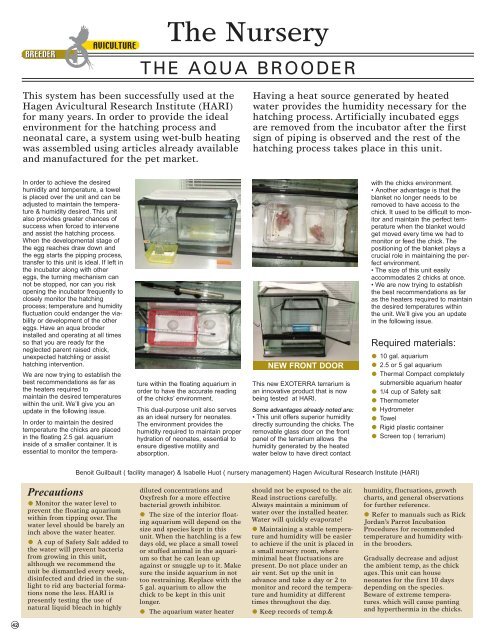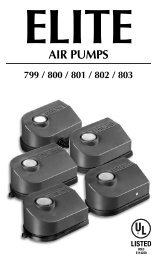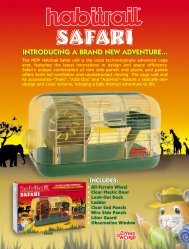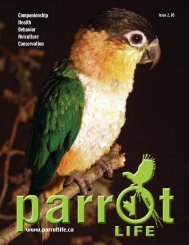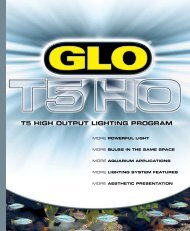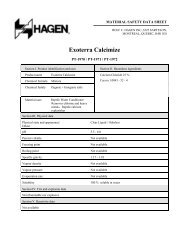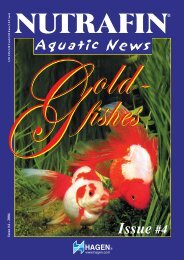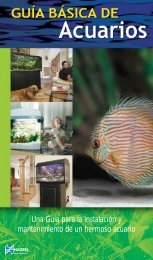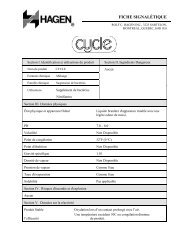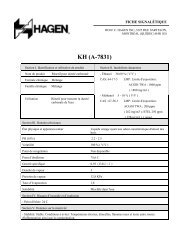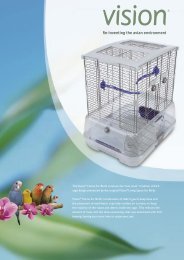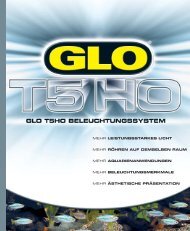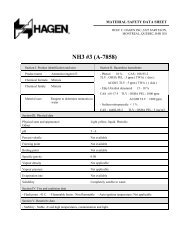parrotLife_Printers-3 (Page 1) - Rolf C. Hagen Inc.
parrotLife_Printers-3 (Page 1) - Rolf C. Hagen Inc.
parrotLife_Printers-3 (Page 1) - Rolf C. Hagen Inc.
Create successful ePaper yourself
Turn your PDF publications into a flip-book with our unique Google optimized e-Paper software.
42<br />
BREEDER BREEDER<br />
AVICULTURE<br />
This system has been successfully used at the<br />
<strong>Hagen</strong> Avicultural Research Institute (HARI)<br />
for many years. In order to provide the ideal<br />
environment for the hatching process and<br />
neonatal care, a system using wet-bulb heating<br />
was assembled using articles already available<br />
and manufactured for the pet market.<br />
In order to achieve the desired<br />
humidity and temperature, a towel<br />
is placed over the unit and can be<br />
adjusted to maintain the temperature<br />
& humidity desired. This unit<br />
also provides greater chances of<br />
success when forced to intervene<br />
and assist the hatching process.<br />
When the developmental stage of<br />
the egg reaches draw down and<br />
the egg starts the pipping process,<br />
transfer to this unit is ideal. If left in<br />
the incubator along with other<br />
eggs, the turning mechanism can<br />
not be stopped, nor can you risk<br />
opening the incubator frequently to<br />
closely monitor the hatching<br />
process; temperature and humidity<br />
fluctuation could endanger the viability<br />
or development of the other<br />
eggs. Have an aqua brooder<br />
installed and operating at all times<br />
so that you are ready for the<br />
neglected parent raised chick,<br />
unexpected hatchling or assist<br />
hatching intervention.<br />
We are now trying to establish the<br />
best recommendations as far as<br />
the heaters required to<br />
maintain the desired temperatures<br />
within the unit. We’ll give you an<br />
update in the following issue.<br />
In order to maintain the desired<br />
temperature the chicks are placed<br />
in the floating 2.5 gal. aquarium<br />
inside of a smaller container. It is<br />
essential to monitor the tempera-<br />
Precautions<br />
Monitor the water level to<br />
prevent the floating aquarium<br />
within from tipping over. The<br />
water level should be barely an<br />
inch above the water heater.<br />
A cup of Safety Salt added to<br />
the water will prevent bacteria<br />
from growing in this unit,<br />
although we recommend the<br />
unit be dismantled every week,<br />
disinfected and dried in the sunlight<br />
to rid any bacterial formations<br />
none the less. HARI is<br />
presently testing the use of<br />
natural liquid bleach in highly<br />
The Nursery<br />
THE AQUA BROODER<br />
ture within the floating aquarium in<br />
order to have the accurate reading<br />
of the chicks’ environment.<br />
This dual-purpose unit also serves<br />
as an ideal nursery for neonates.<br />
The environment provides the<br />
humidity required to maintain proper<br />
hydration of neonates, essential to<br />
ensure digestive motility and<br />
absorption.<br />
diluted concentrations and<br />
Oxyfresh for a more effective<br />
bacterial growth inhibitor.<br />
The size of the interior floating<br />
aquarium will depend on the<br />
size and species kept in this<br />
unit. When the hatchling is a few<br />
days old, we place a small towel<br />
or stuffed animal in the aquarium<br />
so that he can lean up<br />
against or snuggle up to it. Make<br />
sure the inside aquarium in not<br />
too restraining. Replace with the<br />
5 gal. aquarium to allow the<br />
chick to be kept in this unit<br />
longer.<br />
The aquarium water heater<br />
Having a heat source generated by heated<br />
water provides the humidity necessary for the<br />
hatching process. Artificially incubated eggs<br />
are removed from the incubator after the first<br />
sign of piping is observed and the rest of the<br />
hatching process takes place in this unit.<br />
NEW FRONT DOOR<br />
This new EXOTERRA terrarium is<br />
an innovative product that is now<br />
being tested at HARI.<br />
Some advantages already noted are:<br />
• This unit offers superior humidity<br />
directly surrounding the chicks. The<br />
removable glass door on the front<br />
panel of the terrarium allows the<br />
humidity generated by the heated<br />
water below to have direct contact<br />
Benoit Guilbault ( facility manager) & Isabelle Huot ( nursery management) <strong>Hagen</strong> Avicultural Research Institute (HARI)<br />
should not be exposed to the air.<br />
Read instructions carefully.<br />
Always maintain a minimum of<br />
water over the installed heater.<br />
Water will quickly evaporate!<br />
Maintaining a stable temperature<br />
and humidity will be easier<br />
to achieve if the unit is placed in<br />
a small nursery room, where<br />
minimal heat fluctuations are<br />
present. Do not place under an<br />
air vent. Set up the unit in<br />
advance and take a day or 2 to<br />
monitor and record the temperature<br />
and humidity at different<br />
times throughout the day.<br />
Keep records of temp.&<br />
with the chicks environment.<br />
• Another advantage is that the<br />
blanket no longer needs to be<br />
removed to have access to the<br />
chick. It used to be difficult to monitor<br />
and maintain the perfect temperature<br />
when the blanket would<br />
get moved every time we had to<br />
monitor or feed the chick. The<br />
positioning of the blanket plays a<br />
crucial role in maintaining the perfect<br />
environment.<br />
• The size of this unit easily<br />
accommodates 2 chicks at once.<br />
• We are now trying to establish<br />
the best recommendations as far<br />
as the heaters required to maintain<br />
the desired temperatures within<br />
the unit. We’ll give you an update<br />
in the following issue.<br />
Required materials:<br />
10 gal. aquarium<br />
2.5 or 5 gal aquarium<br />
Thermal Compact completely<br />
submersible aquarium heater<br />
1/4 cup of Safety salt<br />
Thermometer<br />
Hydrometer<br />
Towel<br />
Rigid plastic container<br />
Screen top ( terrarium)<br />
humidity, fluctuations, growth<br />
charts, and general observations<br />
for further reference.<br />
Refer to manuals such as Rick<br />
Jordan’s Parrot <strong>Inc</strong>ubation<br />
Procedures for recommended<br />
temperature and humidity within<br />
the brooders.<br />
Gradually decrease and adjust<br />
the ambient temp, as the chick<br />
ages. This unit can house<br />
neonates for the first 10 days<br />
depending on the species.<br />
Beware of extreme temperatures.<br />
which will cause panting<br />
and hyperthermia in the chicks.


